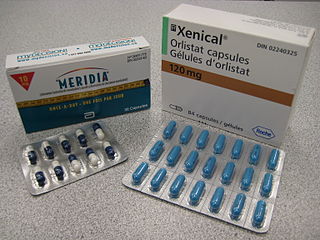Related Research Articles
Insulin resistance (IR) is a pathological condition in which cells in insulin-sensitive tissues in the body fail to respond normally to the hormone insulin or downregulate insulin receptors in response to hyperinsulinemia.

Ghrelin is a hormone primarily produced by enteroendocrine cells of the gastrointestinal tract, especially the stomach, and is often called a "hunger hormone" because it increases the drive to eat. Blood levels of ghrelin are highest before meals when hungry, returning to lower levels after mealtimes. Ghrelin may help prepare for food intake by increasing gastric motility and stimulating the secretion of gastric acid.

Anti-obesity medication or weight loss medications are pharmacological agents that reduce or control excess body fat. These medications alter one of the fundamental processes of the human body, weight regulation, by: reducing appetite and consequently energy intake, increasing energy expenditure, redirecting nutrients from adipose to lean tissue, or interfering with the absorption of calories.

Weight gain is an increase in body weight. This can involve an increase in muscle mass, fat deposits, excess fluids such as water or other factors. Weight gain can be a symptom of a serious medical condition.

Pramlintide is an injectable amylin analogue drug for diabetes, developed by Amylin Pharmaceuticals. Pramlintide is sold as an acetate salt.

Exenatide, sold under the brand name Byetta among others, is a medication used to treat type 2 diabetes. It is used together with diet, exercise, and potentially other antidiabetic medication. It is a treatment option after metformin and sulfonylureas. It is given by injection under the skin.

The glucagon-like peptide-1 receptor (GLP1R) is a G protein-coupled receptor (GPCR) found on beta cells of the pancreas and on neurons of the brain. It is involved in the control of blood sugar level by enhancing insulin secretion. In humans it is synthesised by the gene GLP1R, which is present on chromosome 6. It is a member of the glucagon receptor family of GPCRs. GLP1R is composed of two domains, one extracellular (ECD) that binds the C-terminal helix of GLP-1, and one transmembrane (TMD) domain that binds the N-terminal region of GLP-1. In the TMD domain there is a fulcrum of polar residues that regulates the biased signaling of the receptor while the transmembrane helical boundaries and extracellular surface are a trigger for biased agonism.

Obesogens are certain chemical compounds that are hypothesised to disrupt normal development and balance of lipid metabolism, which in some cases, can lead to obesity. Obesogens may be functionally defined as chemicals that inappropriately alter lipid homeostasis and fat storage, change metabolic setpoints, disrupt energy balance or modify the regulation of appetite and satiety to promote fat accumulation and obesity.
Adipose tissue is an endocrine organ that secretes numerous protein hormones, including leptin, adiponectin, and resistin. These hormones generally influence energy metabolism, which is of great interest to the understanding and treatment of type 2 diabetes and obesity.

Lorcaserin, marketed under the brand name Belviq, was a weight-loss drug developed by Arena Pharmaceuticals. It reduces appetite by activating serotonin receptor the 5-HT2C receptor in the hypothalamus, a region of the brain which is known to control appetite. It was approved in 2012, and in 2020, it was removed from the market in the United States due to an increased risk of cancer detected in users of Belviq.
Glucagon-like peptide-1 (GLP-1) receptor agonists, also known as GLP-1 analogs, GLP-1DAs or incretin mimetics, are a class of anorectic drugs that reduce blood sugar and energy intake by activating the GLP-1 receptor. They mimic the actions of the endogenous incretin hormone GLP-1 that is released by the gut after eating.

Weight management refers to behaviors, techniques, and physiological processes that contribute to a person's ability to attain and maintain a healthy weight. Most weight management techniques encompass long-term lifestyle strategies that promote healthy eating and daily physical activity. Moreover, weight management involves developing meaningful ways to track weight over time and to identify the ideal body weights for different individuals.
Ingestive behaviors encompass all eating and drinking behaviors. These actions are influenced by physiological regulatory mechanisms; these mechanisms exist to control and establish homeostasis within the human body. Disruptions in these ingestive regulatory mechanisms can result in eating disorders such as obesity, anorexia, and bulimia.
Metreleptin, sold under the brand name Myalept among others, is a synthetic analog of the hormone leptin used to treat various forms of dyslipidemia. It has been approved in Japan for metabolic disorders including lipodystrophy and in the United States as replacement therapy to treat the complications of leptin deficiency, in addition to diet, in patients with congenital generalized or acquired generalized lipodystrophy.
Sleep and weight is the association between the amount of sleep an individual obtains and the weight of that individual.

Setmelanotide, sold under the brand name Imcivree, is a medication used for the treatment of genetic obesity caused by a rare single-gene mutation.

Semaglutide is an antidiabetic medication used for the treatment of type 2 diabetes and an anti-obesity medication used for long-term weight management. It is a peptide similar to the hormone glucagon-like peptide-1 (GLP-1), modified with a side chain. It can be administered by subcutaneous injection or taken orally. It is sold under the brand names Ozempic and Rybelsus for diabetes, and under the brand name Wegovy for weight loss.

Tirzepatide is an antidiabetic medication used for the treatment of type 2 diabetes and for weight loss. Tirzepatide is administered via subcutaneous injections. It is sold under the brand names Mounjaro for diabetes treatment, and Zepbound for weight loss.
Glucagon receptor agonists are a class of drugs under development for the treatment of obesity, non-alcoholic fatty liver disease, and congenital hyperinsulinism.
GLP1 poly-agonist peptides are a class of drugs that activate multiple peptide hormone receptors including the glucagon-like peptide-1 (GLP-1) receptor. These drugs are developed for the same indications as GLP-1 receptor agonists—especially obesity, type 2 diabetes, and non-alcoholic fatty liver disease. They are expected to provide superior efficacy with fewer adverse effects compared to GLP-1 mono-agonists, which are dose-limited by gastrointestinal disturbances. The effectiveness of multi-receptor agonists could possibly equal or exceed that of bariatric surgery. The first such drug to receive approval is tirzepatide, a dual agonist of GLP-1 and GIP receptors.
References
- ↑ "Oxyntomodulin regulates resetting of the liver circadian clock by food". www.uni-luebeck.de. University of Lübeck. 30 April 2015. Retrieved 22 September 2018.
- ↑ Hsu, Charlotte (27 January 2016). "Scientists pursue a diabetes drug that also fights obesity". phys.org. Retrieved 22 September 2018.
- ↑ Shankar, Sudha S.; Shankar, R. Ravi; Mixson, Lori A.; Miller, Deborah L.; Pramanik, Barnali; O'Dowd, Amy K.; Williams, Donna M.; Frederick, Clay B.; Beals, Chan R.; Stoch, S. Aubrey; Steinberg, Helmut O. (June 2018). "Native Oxyntomodulin Has Significant Glucoregulatory Effects Independent of Weight Loss in Obese Humans With and Without Type 2 Diabetes". Diabetes. 67 (6): 1105–1112. doi: 10.2337/db17-1331 . ISSN 1939-327X. PMID 29545266.
- ↑ Wynne, Katie; Park, Adrian J.; Small, Caroline J.; Patterson, Michael; Ellis, Sandra M.; Murphy, Kevin G.; Wren, Alison M.; Frost, Gary S.; Meeran, Karim; Ghatei, Mohammad A.; Bloom, Stephen R. (2005-08-01). "Subcutaneous Oxyntomodulin Reduces Body Weight in Overweight and Obese Subjects: A Double-Blind, Randomized, Controlled Trial". Diabetes. 54 (8): 2390–2395. doi: 10.2337/diabetes.54.8.2390 . ISSN 0012-1797. PMID 16046306.